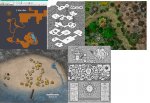Occasionally I'll download something from the web. For example I recently wanted to have a haunted house, so I did a quick search and found something that worked.
But in general I use a piece of paper for an overview and make it up as I go along. I may sketch out a few set pieces (sometimes using grid paper) just to keep straight in my mind what's where and to have a quick reference for my players. For example, if the ruins are an old castle, I'll map where the guard towers are and whatnot.
I used to do detailed dungeon layouts (using either grid or Campaign Cartographer) but I found it didn't really matter. If I have a general idea of who's where, what the general layout is and I go from there. I simply find it easier to say "Bob the Bugbear controls a section of the dungeon and has an uneasy truce with Kob the Kobold" and then jot down some general ideas of how the ruins look different.
In this scenario I'm not going to do anything with the bugbear section of the dungeon other than overall setting and tone. The kobolds? For those I may do a quick sketch of some areas but I'm just as likely to jot down notes about traps, tunnels so narrow only a small creature can get through and so on.
Then again, my adventures tend to be rather free-form where I'm planning factions and events, not set pieces for people to encounter. I'd rather spend my time thinking about what Bob the Bugbear's motivations are and if I can breath more life into him than stats on a page than designing a floor plan. In the bugbear and kobold scenario the group may never actually be under threat when fighting them if they somehow manage to get the two groups fighting each other, so why bother?

